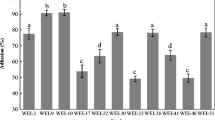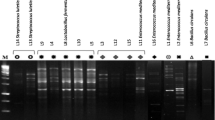Abstract
The aim of this study was to evaluate probiotic properties of ten Streptococcus thermophilus strains (st1 to st10) isolated from pickles in China. These strains all had β-galactosidase activity, which laid foundation for studying their probiotic properties. In this study, the bile salt hydrolase activity, lysozyme resistance, tolerance to simulated gastric juice, bile salt tolerance, and bacterial adhesion capacity to the Caco-2 cells of these selected strains were detected in vitro conditions. The results indicated that the bile salt hydrolase activities of st2, st6, and st9 were higher than that for other strains. St10 showed the greatest lysozyme resistance (> 80% survival), followed by st9, st8, st7, st5, and st6. As for the tolerance to simulated gastric juice, st5 possessed the highest survival rate (35%), followed by st6 (30%). St6 was the best performer in both bile salt tolerance and bacterial adhesion capacity to the Caco-2 cells. The results of fluorescence microscope and electron microscope further confirmed previous studies and more intuitively demonstrated the st6 strain's tolerance to harsh environments. Overall, these strains were expected to possess beneficial properties and have the potentiality to be probiotics.




Similar content being viewed by others
Reference
De VM, Stegelmann A, Richter B, Fenselau S, Laue C, Schrezenmeir J (2001) Probiotics–compensation for lactase insufficiency. Am J Clin Nutr 73(2 Suppl):421S. https://doi.org/10.2337/dc09-1867
Ouwehand AC, Salminen S, Isolauri E (2002) Probiotics: an overview of beneficial effects. Antonie Van Leeuwenhoek 82(1–4):279–289. https://doi.org/10.1023/a:1020620607611
Georgieva R, Iliev I, Haertlé T, Chobert JM, Ivanova I, Danova S (2009) Technological properties of candidate probiotic Lactobacillus plantarum strains. Int Dairy J 19(11):696–702. https://doi.org/10.1016/j.idairyj.2009.06.006
Iyer R, Tomar SK, Kapila S, Mani J, Singh R (2010) Probiotic properties of folate producing Streptococcus thermophilus strains. Food Res Int 43(1):103–110. https://doi.org/10.1016/j.foodres.2009.09.011
Ohland CL, Macnaughton WK (2010) Probiotic bacteria and intestinal epithelial barrier function. Am J Physiol Gastrointest Liver Physiol 298(6):807–819. https://doi.org/10.1152/ajpgi.00243.2009
Lara-Hidalgo CE, Dorantes-Álvarez L, Hernández-Sánchez H, Santoyo-Tepole F, Martínez-Torres A, Villa-Tanaca L, Hernández-Rodríguez C (2018) Isolation of yeasts from guajillo pepper (Capsicum annuum L.) fermentation and study of some probiotic characteristics. Probiotics Antimicrobial Proteins 3:1–17. https://doi.org/10.1007/s12602-018-9415-x
Iseppi R, Stefani S, de Niederhausern S, Bondi M, Sabia C, Messi P (2019) Characterization of anti-listeria monocytogenes properties of two bacteriocin-producing Enterococcus mundtii Isolated from fresh fish and seafood. Curr Microbiol 76(9):1010–1019. https://doi.org/10.1007/s00284-019-01716-6
Silva MS, Ramos CL, González-Avila M, Gschaedler A, Arrizon J, Schwan RF, Dias DR (2017) Probiotic properties of Weissella cibaria and Leuconostoc citreum isolated from tejuino and ash; A typical Mexican beverage. LWT Food Sci Technol 86:227–232. https://doi.org/10.1016/j.lwt.2017.08.009
Yadav V, Gupta VK, Meena GS (2018) Effect of culture levels, ultrafiltered retentate addition, total solid levels and heat treatments on quality improvement of buffalo milk plain set yoghurt. J Food Sci Technol 55(4):1–8. https://doi.org/10.1007/s13197-018-3076-3
Satar R, Ansari SA (2017) Functionalized agarose as an effective and novel matrix for immobilizing Cicer arietinum β-galactosidase and its application in lactose hydrolysis. Braz J Chem Eng 34(2):451–457. https://doi.org/10.1590/0104-6632.20170342s20160107
Zago M, Fornasari ME, Carminati D, Burns P, Suàrez V, Vinderola G, Reinheimer J, Giraffa G (2011) Characterization and probiotic potential of Lactobacillus plantarum strains isolated from cheeses. Food Microbiol 28(5):1033–1040. https://doi.org/10.1016/j.fm.2011.02.009
Santos KMOD, Vieira ADS, Buriti FCA, Melo MESD, Bruno LM, Borges MDF, Rocha CRC, Lopes ACDS (2015) Artisanal Coalho cheeses as source of beneficial Lactobacillus plantarum and Lactobacillus rhamnosus strains. Dairy Sci Technol 95(2):209–230. https://doi.org/10.1007/s13594-014-0201-6
Moser SA, Savage DC (2001) Bile salt hydrolase activity and resistance to toxicity of conjugated bile salts are unrelated properties in lactobacilli. Appl Environ Microbiol 67(8):3476–3480. https://doi.org/10.1128/AEM.67.8.3476-3480.2001
Shi C, Song K, Zhang X, Sun Y, Sui Y, Chen Y, Jia Z, Sun H, Sun Z, Xia X (2016) Antimicrobial activity and possible mechanism of action of citral against Cronobacter sakazakii. PLoS ONE 11(7):e0159006. https://doi.org/10.1371/journal.pone.0159006
Garcíaruiz A, González DLD, Estebanfernández A, Requena T, Bartolomé B, Morenoarribas MV (2014) Assessment of probiotic properties in lactic acid bacteria isolated from wine. Food Microbiol 44(6):220 225. https://doi.org/10.1016/j.fm.2014.06.015.
Kang WL, Shim JM, Park SK, Heo HJ, Kim HJ, Ham KS, Kim JH (2016) Isolation of lactic acid bacteria with probiotic potentials from kimchi, traditional Korean fermented vegetable. LWT Food Sci Technol 71:130–137. https://doi.org/10.1016/j.lwt.2016.03.029
Pilar FDP, Paloma L, Angelluis C, Carmen P, Teresa R (2008) Probiotic strains: survival under simulated gastrointestinal conditions, in vitro adhesion to Caco-2 cells and effect on cytokine secretion. Eur Food Res Technol 227(5):1475–1484. https://doi.org/10.1007/s00217-008-0870-6
Liu M, Yang K, Wang J, Zhang J, Qi Y, Wei X, Fan M (2018) Young astringent persimmon tannin inhibits methicillin-resistant Staphylococcus aureus isolated from pork. LWT Food Sci Technol 100:48–55. https://doi.org/10.1016/j.lwt.2018.10.047
Cárdenas N, Laiño JE, Delgado S, Jiménez E, Juárez DVM, Savoy DGG, Sesma F, Mayo B, Fernández L, Leblanc JG (2015) Relationships between the genome and some phenotypical properties of Lactobacillus fermentum CECT 5716, a probiotic strain isolated from human milk. Appl Microbiol Biotechnol 99(10):4343–4353. https://doi.org/10.1007/s00253-015-6429-0
Begley M, Hill C, Gahan CGM (2006) Bile salt hydrolase activity in probiotics. Appl Environ Microbiol 72(3):1729. https://doi.org/10.1128/AEM.72.3.1729-1738.2006
Hamon E, Horvatovich P, Bisch M, Bringel F, Marchioni E, Aoudéwerner D, Ennahar S (2011) Investigation of biomarkers of bile tolerance in Lactobacillus casei using comparative proteomics. J Proteome Res 11(1):109–118. https://doi.org/10.1021/pr200828t
Bustos AY, Saavedra L, de Valdez GF, Raya RR, Taranto MP (2012) Relationship between bile salt hydrolase activity, changes in the internal pH and tolerance to bile acids in lactic acid bacteria. Biotechnol Lett 34(8):1511–1518. https://doi.org/10.1007/s10529-012-0932-5
Bove P, Gallone A, Russo P, Capozzi V, Albenzio M, Spano G, Fiocco D (2012) Probiotic features of Lactobacillus plantarum mutant strains. Appl Microbiol Biotechnol 96(2):431–441. https://doi.org/10.1007/s00253-012-4031-2
Corzo G, Gilliland SE (1999) Bile salt hydrolase activity of three strains of Lactobacillus acidophilus 1. J Dairy Sci 82(3):472. https://doi.org/10.3168/jds.S0022-0302(99)75256-2
Mansouri H (2011) Asrar Z (2011) Importance of IL-10 modulation by probiotic microorganisms in gastrointestinal inflammatory diseases. ISRN Gastroenterology 2:155–170. https://doi.org/10.5402/2011/892971
Castellano P, Ibarreche MP, Borges LL, Arias FCN, Ross GR, Martinis ECPD (2018) Lactobacillus spp. impair the ability of Listeria monocytogenes FBUNT to adhere to and invade Caco-2 cells. Biotechnol Lett 40(8):1237–1244. https://doi.org/10.1007/s10529-018-2572-x
Wang Z, Cui Y, Zhang Z, Wang J, Yin N (2014) Evaluation on the human bioavailability of metals using Caco-2 cell model: a review. Asian J Ecotoxicol. https://doi.org/10.7524/AJE.1673-5897-20131224001
Ge Z, Nie R, Maimaiti T, Yao F, Li C (2016) Comparison of the inhibition on cellular 22-NBD-cholesterol accumulation and transportation of monomeric catechins and their corresponding A-type dimers in Caco-2 cell monolayers. J Funct Foods 27:343–351. https://doi.org/10.1016/j.jff.2016.09.018
Casarotti SN, Carneiro BM, Todorov SD, Nero LA, Rahal P, Penna ALB (2017) In vitro assessment of safety and probiotic potential characteristics of Lactobacillus strains isolated from water buffalo mozzarella cheese. Ann Microbiol 67(4):289–301. https://doi.org/10.1007/s13213-017-1258-2
Collado MC, Jalonen L, Meriluoto J, Salminen S (2006) Protection mechanism of probiotic combination against human pathogens: in vitro adhesion to human intestinal mucus. Asia Pac J Clin Nutr 15(4):570–575. https://doi.org/10.1016/j.appet.2005.10.003
Williams T, Christèle H, Marie-Louise N, Muriel T, Jean-Pierre G (2012) Lactobacillaceae and cell adhesion: genomic and functional screening. PLoS ONE 7(5):e38034. https://doi.org/10.1371/journal.pone.0038034
Botta C, Langerholc T, Cencič A, Cocolin L (2014) In vitro selection and characterization of new probiotic candidates from table olive microbiota. PLoS ONE 9(4):e94457. https://doi.org/10.1371/journal.pone.0094457
Luo Y (2012) Identification and characterization of lactic acid bacteria from forest musk deer feces. Afr J Microbiol Res 6(29):5871–5881. https://doi.org/10.5897/AJMR12.807
Fan S, Breidt F, Price R, Pérez-Díaz I (2016) Survival and growth of probiotic lactic acid bacteria in refrigerated pickle products. J Food Sci 82(1):167–173. https://doi.org/10.1111/1750-3841.13579
Schubert K, Swm OD, Von BM, Schaap FG (2017) Interactions between bile salts, gut microbiota, and hepatic innate immunity. Immunol Rev 279(1):23. https://doi.org/10.1111/imr.12579
Acknowledgements
This work was supported by the Ministry of Agriculture of Peoples’ Republic of China (Grant No. 201503142–10). Prof. Wu Ding of Northwest A&F University is acknowledged for providing Lactobacillus rhamnosus GG strains.
Author information
Authors and Affiliations
Corresponding author
Ethics declarations
Conflict of interest
The authors declare that they have no conflict of interest.
Research Involving Human and Animal Participants
This article does not contain any studies with human or animal subjects.
Additional information
Publisher's Note
Springer Nature remains neutral with regard to jurisdictional claims in published maps and institutional affiliations.
Rights and permissions
About this article
Cite this article
Zhang, J., Liu, M., Xu, J. et al. First Insight into the Probiotic Properties of Ten Streptococcus thermophilus Strains Based on In Vitro Conditions. Curr Microbiol 77, 343–352 (2020). https://doi.org/10.1007/s00284-019-01840-3
Received:
Accepted:
Published:
Issue Date:
DOI: https://doi.org/10.1007/s00284-019-01840-3




